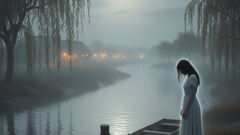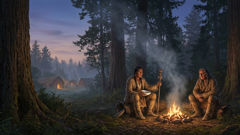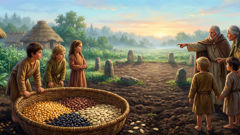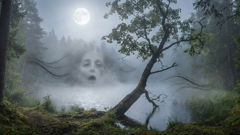Introduction
On certain nights along the slow arcs of Mexico’s rivers, where moonlight pools in the shallows and reedbeds breathe with an old hush, people say the water remembers its own tragedies. The La Llorona—literally, the weeping woman—moves through that remembering as if guided by a sorrow so steady it has become a geography. Her wail is not a single sound but a tide: a low, keening note that rises like vapor and drifts through alleys, under bridges, and along canals where children once played. Each town has its hour for her arrival, an hour when dogs fall silent and the lamps in kitchens seem to tilt their light toward the river. Some say she was a woman of terrible choice, a mother who could not bear a life that failed to match her dream; others speak of betrayal, of a lover who left a woman with nothing but the hollow sound of infants she could not keep. There are versions that make her monstrous, versions that make her pitiful, but all agree on the same small facts: she searches, she cries, and those who hear her are changed. This story moves between reeds and rooftops, between whispered testimony and the slow backwash of history. It attends to how La Llorona’s legend acts as both warning and compassionate witness—how her lament preserves a complicated truth about motherhood, guilt, and survival. Across time, people have told this tale to frighten children away from dangerous water, to explain unexplained drownings, or to hold tenderly to the idea that grief can become a presence. As you read, imagine the river as a long, listening thing; imagine a woman’s sorrow shaping itself into whisper and water. When you approach the banks in this tale, watch for the reflections that are not quite your own.
Origins, Variations, and the Shape of a Sorrow
The story of La Llorona moves through generations much like the rivers in which she’s said to appear: shifting course, depositing new sediment of meaning, carving different banks. In some tellings, especially those told near the larger colonial cities, she is a woman of striking beauty who loved above her station. She marries, bears children, and then loses everything when the man she loved abandons her for a wealthier match. Driven by despair or madness—versions vary—she drowns her children and, realizing the horror of her deed, kills herself or is cursed to wander, searching for her lost offspring. The sound she makes is a keening that slices the hum of evening, a sound that children learn to dread because it signals danger near water. In other versions, older and perhaps closer to indigenous roots, the figure may be read less as a fallen woman and more as a spirit who embodies communal grief: droughts, kidnappings, and the loss of kin under conquest’s weight. That reading loosens the story from moralizing judgment and tightens it into an acknowledgment of how women’s grief has been folded into cultural trauma.

Those who collect folklore in the highlands will tell you that the first times La Llorona appeared in oral history are impossible to date. She seems to arrive wherever rivers meet villages and where those villages hold silence around certain episodes—an epidemic that took children, a river that swallowed a canoe, a massacre whose bodies were never found. Over time, the figure accrues details like barnacles: a white dress stained with mud and algae, hair that hangs in dark ropes, eyes edged with endless tears. The dress is one of the most persistent symbols because it is both plain and conspicuous; wedding cloth, peasant shift, whatever the garment, it becomes a marker of a woman who once belonged and now does not. This attire, when rendered in moonlight, becomes less fabric than concept: an emblem of liminality, standing between human regret and ghostly persistence.
Anthropologists and storytellers note how the tale has been adapted to different social ends. In some communities La Llorona functions as a cautionary tale directed at children—stay away from the river after dusk, mind your parents’ warnings—an effective, if chilling, parenting tool. In other contexts, her story is used to police women’s behavior, a spectral enforcer whispering that transgression against family or social order will have terrible consequences. Yet other narrators, especially women, recast La Llorona into a figure of empathy. In these versions, maternal failure becomes a human frailty, and La Llorona is, painfully, every mother who has ever had to choose between ruinous options. She is, in this light, a social mirror: those who see only the monster may be missing the portrait of a person crushed by circumstance.
The legend’s endurance owes much to its elasticity. When Spanish colonizers arrived and encountered indigenous water spirits—beings associated with rivers, lakes and life—they did not so much eradicate those figures as fold them into new narratives. A Mesoamerican water deity might have been rendered with Christian colors, the loss reframed in terms of sin and penance. The colonial archive provides a palimpsest where indigenous memory and European theological thinking overlap. Across centuries, La Llorona cycles between roles: a pagan lament, a Christian allegory, a psychological case study of a woman broken by abandonment, an emblem of collective tragedy. Contemporary storytellers and artists have continued this work of reinterpretation, writing La Llorona into novels, films and music, each retelling reflecting present anxieties—about migration, gender violence, and environmental destruction. When rivers dry up or grow dangerous because of pollution and damming, the figure of the weeping woman acquires new resonance: water becomes a contested resource and the ghost’s lament turns into a political commentary.
Beyond formal variations, the legend operates at a level of sensory detail that keeps it vivid. Listen to accounts from villagers and fishermen: they speak of a chill that passes along the skin, of the way the hair on a forearm bristles when the wail rises. They speak of reflections that do not line up—an extra shadow in the water, a second face in the ripple. Children insist they see a woman combing hair at the river’s edge, or calling out in a voice that sounds like their mother’s. Some older men, who remember the story from their abuelas, will say that La Llorona appears to remind people of what the river has swallowed: names, laughter, future bread. Others will say less kindly that she is a hungry phantom, a predator of loose children and wandering lovers. Both readings are instructive because they tell us how fear and sorrow are braided together in communal memory. The legend endures because it satisfies a human need to give form to the formless—to make a sound that names loss.
What does it mean for a community to share such a story? It means, in part, that La Llorona performs a social calculus: she keeps the young from peril, she encodes moral instruction, but she also keeps open a space of empathy for those who suffer. The legend acts like a lingua franca of grief, one that allows grief to be spoken about under the guise of the supernatural. People will tell the tale at bonfires and at wakes, in classrooms and at border crossings, and each context shades the story differently. Yet after decades or centuries of retelling, the core remains: a woman who weeps, whose tears are visible both as water on her cheeks and as the metaphorical water of memory. That duality—material and metaphorical—gives La Llorona her persistence. She is not only a specter to frighten children away from water; she is a cultural form that helps communities hold the unwieldy concept of loss. In the river’s mirror she is both warning and elegy, a lament that bends light and history into a single sound.
Encounters, Warnings, and the Modern River
The modern river is not the same river that first heard the legend. Dams re-route tributaries, concrete channels harden banks, and the slow dark water that once kept secrets now carries plastics and the smell of gasoline. Yet in these altered waters La Llorona’s presence is not extinguished; instead, it adapts. In towns along urban channels, office workers and night-shift drivers whisper about a wet figure pressed against bridges; in farming communities, irrigation canals—dangerous and oddly lonely—become the stage for sightings. One of the reasons the myth persists in contemporary life is that it flexes to speak to new dangers. Parents still use the story to keep children from playing near a fast current or a culvert. Teenagers, in their own mix of bravado and dread, recreate the legend with dares: call out “La Llorona” three times at midnight and see if she answers. Some of those dares are harmless. Others end in panic when teenagers, frightened by their own shadows, learn the too-ancient human lesson about how stories can catalyze fear. When someone drowns in a canal that had been dry in years prior, the community will sometimes say, as if to keep sorrow tethered to a name, that La Llorona was calling.

Occasionally, the story shifts into a different register: a modern retelling that asks not whether the woman was guilty but what the society that created her demanded of mothers. Feminist writers reclaim La Llorona, portraying her as a mother punished by a patriarchal order that gives women little recourse when abandoned or abused. In these narratives, her act is not sanitized but is reframed as the tragic consequence of social structures that limit women’s choices. Some contemporary artists make large, public installations by rivers—soundscapes of a woman’s cry layered with the recorded voices of mothers who have lost children to migration or violence. These projects provoke, and not everyone agrees with them; to some, they can feel like an exploitation of real grief by artistic spectacle. Yet they also function as a national conversation about who gets to speak for suffering and how storytelling can be a way to bear witness.
Eyewitness accounts of La Llorona are as varied as the people who claim them. A boatman remembers hearing sobbing at three in the morning, a sound like wind trapped between reeds, and seeing a slow figure walking on the surface of shallow water as if the river had become a floor. An elderly seamstress tells of waking to the sound of a woman singing in a voice that curled like smoke and finding her apron damp with tears although she had not been outdoors. A child awakens to the whisper, “Mamá,” and runs to the window to see a silhouette glide behind the carob trees by the arroyo. Skeptics point to environmental conditions—nighttime wind through channels, the echoing of geese, the human brain’s propensity for pattern-finding. Yet even skeptics nod to the story’s power; they remark on how the narrative holds communities together around shared fears, warnings and empathetic reckonings. The question of whether La Llorona is “real” in a literal sense is less interesting, perhaps, than the fact of her reality in cultural and psychological terms. She exists in the way a river holds sediment: permanently, quietly, altering the bank over time.
There are also moments when the story intersects with political reality. At border towns where crossings are fraught with displacement and drowning is tragically common, La Llorona’s weeping takes on specific, wrenching associations. Families who have lost children to the current speak of her not as a warning but as a grieving mother who understands their specific pain. Migrant shelters will sometimes hear the tale recited to comfort those who cannot place their sorrow; La Llorona becomes a companion figure, a supernatural aunt who has learned the geography of loss. In these contexts the legend becomes ethically complicated: its deployment can open wounds while also speaking truth to those who have known similar devastation. The legend’s power, again, is that it holds multiple senses at once—moral, cultural, psychological, political.
The present-day presence of La Llorona also plays out in law and public safety. Municipalities that aim to prevent drownings use the story in campaigns: posters at riverbanks telling parents about the dangers of letting children play near water, warnings issued in local radios reminding fishermen to secure boats. A benefit of these pragmatic uses is that they translate folklore into concrete behavior change. Yet there is always the flip side, in which the story is invoked to shame single mothers or to blame victims for misfortune. Community leaders who deeply understand the legend’s nuance will resist simplistic uses; they will teach that the story is not only punishment but also an invitation to look at the social conditions that produce tragedy.
At its most human level, the encounters with La Llorona are stories about listening. Whether the sound is supernatural or the product of human anxieties made audible, it asks the listener to pay attention to the cries of others. In many retellings, La Llorona’s search never ends; she roams because she cannot reconcile her loss, because the current keeps carrying away what she seeks. That endlessness is the legend’s bleak grace. In hearing her, communities are reminded of their obligations: to protect children from water and to protect the living from conditions that create sorrow. The weeping woman, who once haunted narrow colonial canals and now haunts polymer-lined irrigation ditches, continues to teach a complicated lesson. She is a cautionary figure, a symbol of punishment, a mirror of societal failure—and, for those who choose to see her that way, a ghostly advocate for those who have lost children to violence, migration or neglect. Her lament moves like the river itself: sometimes a whisper, sometimes a roar, always a sound that insists on being heard.
Conclusion
La Llorona is not merely a cautionary whisper for children who might stray toward the water; she is a living emblem that carries centuries of grief, judgement, and compassion in her cry. Whether read as a monstrous woman punished for a transgression, as a tragic mother crushed by circumstance, or as a communal figure who holds the unnameable losses of society, her presence continues to shape how people relate to rivers, to children, and to one another. The legend persists because it performs work that straightforward reportage cannot: it wraps caution in narrative, it furnishes empathy through fright, and it allows communities to name sorrow in a single, shared language. In towns where the river still remembers, parents teach their children to respect water and neighbors teach one another to care; artists and activists name bigger patterns of violence and neglect in her wail. Most of all, the story reminds us that grief can become a force that never sleeps—to be listened to, to be reckoned with, and to be met with both practical care and stories that hold memory. If you stand at a river’s edge on a moonlit night and hear an unearthly keening, it might be the wind, or a cry that belongs to the water itself. It might be La Llorona, searching without end. In that keening there is both a warning and an invitation: beware the dangers near the bank, and also remember those who were lost. To remember is, perhaps, the closest thing we have to redemption.













